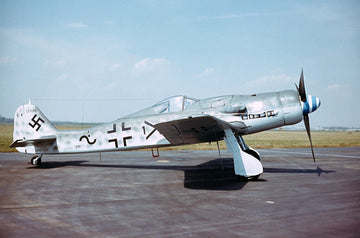Introduction
The Focke-Wulf Fw 190D-9, often referred to as the "Dora" or "Long-Nose Dora," stands out as one of the most formidable fighter aircraft of the German Luftwaffe during World War II. Developed as an advanced variant of the highly successful Fw 190 series, the D-9 was designed to address the shortcomings of earlier radial-engine versions at high altitudes. With its distinctive elongated nose housing a powerful inline engine, the Fw 190D-9 combined speed, agility, and firepower, making it a respected adversary in the skies over Europe.

Development and Design Evolution
The Fw 190 series, designed by Kurt Tank, initially featured a robust BMW 801 radial engine, which provided excellent low-to-medium altitude performance. However, as the war progressed and Allied bombers operated at higher altitudes, the Luftwaffe required an interceptor capable of matching this challenge. This need led to the development of the "Dora" series, which incorporated a liquid-cooled Junkers Jumo 213 inline engine.
The integration of the Jumo 213A engine necessitated significant airframe modifications. The elongated nose, which earned the aircraft its "Long-Nose" nickname, was required to accommodate the new powerplant and its associated systems. To maintain the aircraft's center of gravity, the fuselage was lengthened by inserting an additional section aft of the cockpit. The tail assembly was also modified, adopting a larger vertical stabilizer to improve stability and control at high speeds and altitudes.
Technical Specification
The aircraft is powered by a Junkers Jumo 213A-1 liquid-cooled V12 engine, producing 1,750 horsepower, which can be boosted to 2,240 horsepower with MW 50 water-methanol injection. It reaches a maximum speed of 426 mph (685 km/h) at an altitude of 21,650 feet (6,600 meters) and has a range of 520 miles (835 km). The service ceiling is 39,370 feet (12,000 meters), allowing it to operate effectively at high altitudes. Its armament includes two 13 mm MG 131 machine guns mounted above the engine cowling and two 20 mm MG 151/20 cannons positioned in the wing roots. The aircraft's dimensions are a wingspan of 34 feet 5 inches (10.5 meters), a length of 33 feet 6 inches (10.2 meters), and a height of 11 feet 3 inches (3.43 meters).
Operational History
The Fw 190D-9 entered service in late 1944, with its first operational units being the III./JG 54 "Grünherz" (Green Hearts) fighter wing. The aircraft quickly proved its mettle against both Allied bombers and fighters. Its combination of speed, high-altitude performance, and heavy armament allowed it to intercept and effectively engage the formidable American B-17 Flying Fortresses and B-24 Liberators, as well as to dogfight with agile Allied fighters like the P-51 Mustang and the Spitfire Mk IX.
One of the most notable operational uses of the Fw 190D-9 was during the defense of the German homeland against the relentless Allied bombing campaigns. It was also heavily involved in the Ardennes Offensive (Battle of the Bulge) in late 1944 and early 1945. The D-9’s performance was so impressive that it was often used in "top cover" roles for the advanced jet-powered Messerschmitt Me 262, providing protection during takeoff and landing phases when the jets were most vulnerable.

FW-190 D9, probably one of the best German fighters of the war, with Leutnant Kurt Tanzer, Staffelkapitän of 13./JG 51, contemplates his final flight from Parchim/Redlin to Flensburg on 2 May 1945 to await the arrival of British forces and surrender.
Pilot Impressions and Combat Effectiveness
Pilots who flew the Fw 190D-9 generally praised its performance. The aircraft’s powerful engine provided excellent acceleration and climb rates, while its responsive controls made it highly maneuverable. The "Dora" maintained the ruggedness and ease of handling characteristic of the earlier Fw 190 variants, but with enhanced high-altitude capabilities.
In combat, the D-9 proved to be a versatile and deadly opponent. Its armament was sufficient to down heavily armored bombers, and its speed allowed it to engage or disengage from dogfights at will. However, by the time the Fw 190D-9 was introduced, the Luftwaffe was struggling with fuel shortages, experienced pilot attrition, and overwhelming Allied air superiority, limiting the aircraft’s potential impact on the overall air war.

Captured Focke-Wulf Fw 190 D-9 fighters now flying for the Soviet Air Force.
Variants and Legacy
While the D-9 was the most produced variant of the "Dora" series, other versions such as the Fw 190D-11 and D-13 were developed, featuring improved armament and engines. The D-13, for instance, was equipped with a 30 mm MK 108 cannon firing through the propeller hub, enhancing its bomber-killing capabilities.
Despite its late introduction, the Fw 190D-9 left a significant mark in aviation history. Its design influenced post-war aircraft development, and surviving examples are highly prized by collectors and aviation museums. The "Dora" remains a symbol of German engineering prowess and a testament to the relentless innovation driven by the exigencies of war.
Conclusion
The Focke-Wulf Fw 190D-9 represented the pinnacle of piston-engine fighter development in Nazi Germany. Though it arrived too late to alter the outcome of World War II, its advanced design and impressive performance ensured it a lasting legacy among the legendary aircraft of the conflict. The "Long-Nose Dora" continues to captivate aviation enthusiasts and historians alike, serving as a reminder of the technological advancements and the intense aerial battles of the Second World War.
